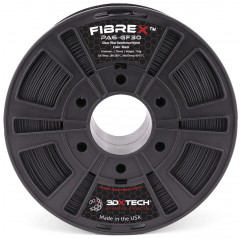Package Contains: 1 x FIBREX NYLON+GF30 - Black / 1.75mm / 750g - 3DXTech
Our fiberglass-reinforced Nylon 6 copolymer Nylon + GF30 (PA6) is nothing less than an industrial-grade beast! Formulated to be exceptionally stiff and strong, all without being brittle. Polyamides (PA) are the workhorse of the plastics industry worldwide due to their excellent mechanical, chemical and thermal resistance. The addition of heavy glass fiber reinforcement takes it to the next level.
Benefits of Nylon+GF30 include:
Printable on virtually any 3D printer with a heated bed
Ideal for structural engineering applications
Exceptionally stiff and strong without being brittle
Excellent chemical resistance makes it suitable for automotive and industrial applications
Resists fuels, lubricants, heat and mechanical loading
High thermal properties keep it strong up to 170°C during use, depending on the print and mechanical loads applied
Glass fiber reinforcement improves dimensional stability, reduces shrinkage, lifting and warping
Very strong layered bonding
Filament specifications:
1.75 mm and 2.85 mm +/- 0.05 mm diameter
Recommended print settings:
Extruder: 260-280°C
Bed temperature: 60-75°C
Nozzle: we currently recommend a hardened steel nozzle with a minimum diameter of 0.4 mm
Other: the ideal layer height is 60% of the nozzle diameter. We do not recommend printing layers smaller than 0.25 mm with glass fiber reinforced filaments
Bed Prep: Magigoo Bed Prep or 3DXTECH Polyimide Tape give us the best results
Heated Chamber: not necessary, but a 30-80°C chamber improves the bonding of the layers and the mechanical properties of the finished parts
Supports: the universal support material AquaTek? X1 water-soluble USM is ideal for complex parts.
Drying instructions: 90°C for 4 hours.
Abrasive Material
This material is particularly abrasive among 3D printing filaments. Users may find that standard brass nozzles are chewed up very quickly compared to standard wear. If worn, the nozzle diameter will expand inconsistently and the printer will encounter extrusion problems.
For this reason, we strongly recommend printing this material through a hardened steel nozzle rather than a softer metal. Hardened steel nozzles can often be inexpensive and easy to install depending on the printer manufacturer's instructions.












